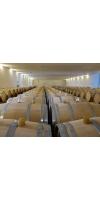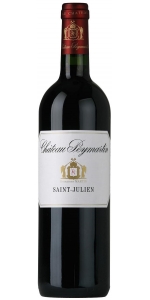Wine from Chateau Gloria

Château Gloria was founded and assembled by Henri Martin who established the reputation of the property within the space of a generation. With the first acquisition of 15 acres (6 hectares) of vines in 1942, and purchase of the chai of Château Saint-Pierre, Martin added to the estate over the years with land bought from surrounding classified estates, including Château Saint-Pierre, Beychevelle, Léoville Poyferré, Gruaud-Larose, Léoville-Barton, Ducru- Beaucaillou, and Lagrange. The estate now encompasses nearly 124 acres (50 hectares) Peymartin is Château Gloria’s second wine, produced using the youngest vines on the estate.
Location of Vineyard
The patchwork of vineyards that comprise Gloria are spread out over three distinct zones: the center of the commune Saint-Julien-Beychevelle, an area to the west, and an area to the north bordering the appellation of Pauillac. The average vine age is 40 years, and the soil is made up of Gunzian gravel covering a layer of clay and sand. The plantings are 65% Cabernet Sauvignon, 25% Merlot, 5% Cabernet Franc, and 5% Petit Verdot.
Winemaking Philosophy
After a manual harvest, the grapes are vinified in thermo regulated stainless steel vats with malolactic occurring in barrel. The wine spends approximately 12 months in cask, a third of which are replaced every year. The ensuing style of wine is typically a lighter and more elegant St. Julien, known for its early drinkability and charming character.
Chateau Peymartin Saint-Julien is made from 65% Cabernet Sauvignon, 25% Merlot, 5% Petit Verdot.
Peymartin is the second wine of Gloria, produced using the youngest vines (average 40 years-old) on the estate.
After a manual harvest, the grapes are vinified in thermo regulated stainless steel vats with malolactic in barrel. Peymartin spends approximately one year in cask followed by additional aging at the estate in bottel prior to release. The ensuing style of wine is typically a lighter and more elegant St. Julien, known for its early drinkability and charming character.
Tasting Notes:
Deep ruby-garnet in appearance, Peymartin is classic left-bank Bordeaux. Aromas of dried tobaco, cedar, blackcurrant, and pungent cooking spices greet the nose. The palate is extremely elegant with ripe, yet structured tannins balanced by firm acidity, black fruits, savory earth, and hints of toasted vanilla. A balanced and persistent finish underlines the wine's quality as well as its ability to hold up in bottle.
- back
Selected Options
Wineries
Categories
Pricing
Countries
Regions
Grape Types
Wineries
Organic/Free Shipping
Capanna Brunello di Montalcino Riserva 2015
TYPE: DOCG
BLEND: 100% Sangiovese carefully selected in the oldest vineyards and only of the best harvests.
VINIFICATION:
Alcoholic fermentation with maceration of the skins (30-35 days) at a controlled temperature and spontaneous malolactic fermentation, both in truncated cone-shaped Slavonian oak vats.
AGEING:
In Slavonian oak casks of 10 to 25 hl for over 40 months; followed by ageing in bottles for at least 15 months.
NOTES:
Colour: deep ruby red, strong, lively.
Bouquet: very intense and complex, fruity and spicy, with red fruit, jam and liquorice shades; great prospects of future development.
Taste: great structure in the acid-tannin components, well supported by the soft ones; extremely persistent.
Food pairings: roast red meats, game and very aged cheeses.
Review:
Powerful, sparkling garnet red. Rich, very appealing nose with notes of ripe raspberries and fresh plums, some liquorice and fine spice notes in the background. Grippy, fine-meshed tannin on the palate, builds up in many layers, salty, good tension, very long finish in the finish.
- Falstaff 98 Points
Shenandoah University’s 150th anniversary white showcases albariño, a Spanish grape which Chrysalis Vineyards, the producer of this wine, helped bring to Virginia. Albariño is proving popular in Virginia, with its botanical aroma, bright acidity, and notes of peach and green apple. Drink on its own or with light meals such as seafood. The wine’s name recognizes the rolling hills of the university’s Shenandoah Valley home.





